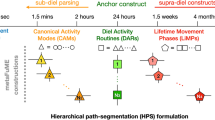Abstract
This paper discusses a temporal data clustering system that is based on the Hidden Markov Model(HMM) methodology. The proposed methodology improves upon existing HMM clustering methods in two ways. First, an explicit HMM model size selection procedure is incorporated into the clustering process, i.e., the sizes of the individual HMMs are dynamically determined for each cluster. This improves the interpretability of cluster models, and the quality of the final clustering partition results. Secondly, a partition selection method is developed to ensure an objective, data-driven selection of the number of clusters in the partition. The result is a heuristic sequential search control algorithm that is computationally feasible. Experiments with artificially generated data and real world ecology data show that: (i) the HMM model size selection algorithm is effective in re-discovering the structure of the generating HMMs, (ii) the HMM clustering with model size selection significantly outperforms HMM clustering using uniform HMM model sizes for re-discovering clustering partition structures, (iii) it is able to produce interpretable and “interesting” models for real world data.
Access this chapter
Tax calculation will be finalised at checkout
Purchases are for personal use only
Preview
Unable to display preview. Download preview PDF.
Similar content being viewed by others
References
A. P. Dempster, N. M. Laird, and D. B. Rubin. Maximum likelihood from incomplete data via the em algorithm. Journal of Royal Statistical Society Series B(methodological), 39:1–38, 1977.
D Heckerman, D. Geiger, and D. M. Chickering. A tutorial on learning with bayesian networks. Machine Learning, 20:197–243, 1995.
M. Jordan. AAAI Tutorial on Graphical Models and Variational Approximation. 1998.
T. Kosaka, S. Masunaga, and M. Kuraoka. Speaker-independent phone modeling based on speaker-dependent hmm’s composition and clustering. In Proceedings of the ICASSP’ 95, pages 441–444, 1995.
C. Li. A Bayesian Approach to Temporal Data Clustering using the Hidden Markov Model Methodology. PhD thesis, Vanderbilt University, December 2000.
C. Li and G. Biswas. Bayesian temporal data clustering using hidden markov model representation. In P. Langley, editor, Proceedings of the 17th International conference on Machine Learning, pages 543–550. Morgan Kaufmann Publishers, 2000.
L. R. Rabiner. A tutorial on hidden markov models and selected applications in speech recognition. Proceedings of the IEEE, 77(2):257–285, February 1989.
P. Sebastiani, M. Ramoni, P. Cohen, J. Warwick, and J. Davis. Discovering dynamics using bayesian clustering. In Proceedings of the 3rd International Symposium on Intelligent Data Analysis, August 1999.
P. Smyth. Clustering sequences with hidden markov models. Advances in Neural Information Processing, 1997.
Author information
Authors and Affiliations
Editor information
Editors and Affiliations
Rights and permissions
Copyright information
© 2001 Springer-Verlag Berlin Heidelberg
About this paper
Cite this paper
Li, C., Biswas, G., Dale, M., Dale, P. (2001). Building Models of Ecological Dynamics Using HMM Based Temporal Data Clustering — A Preliminary Study. In: Hoffmann, F., Hand, D.J., Adams, N., Fisher, D., Guimaraes, G. (eds) Advances in Intelligent Data Analysis. IDA 2001. Lecture Notes in Computer Science, vol 2189. Springer, Berlin, Heidelberg. https://doi.org/10.1007/3-540-44816-0_6
Download citation
DOI: https://doi.org/10.1007/3-540-44816-0_6
Published:
Publisher Name: Springer, Berlin, Heidelberg
Print ISBN: 978-3-540-42581-6
Online ISBN: 978-3-540-44816-7
eBook Packages: Springer Book Archive




